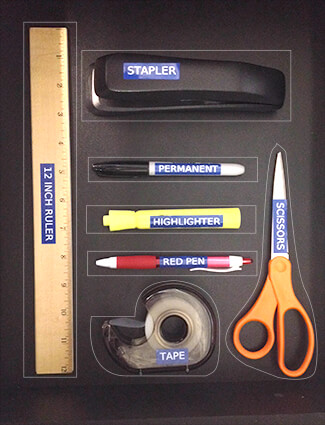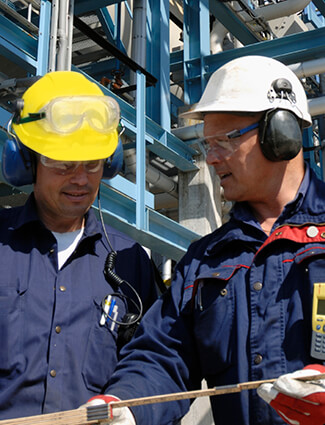5S Examples in Action: The Good and the Bad
03
February,
2023
4 MINUTE READ

The 5S system is a powerful lean manufacturing tool with the potential to improve productivity and profitability. The tenets are seemingly simple and straight-forward: Sort, Set, Shine, Standardize, and Sustain. Success stories, like Toyota's, have inspired many companies to implement 5S as a means to become lean, yet many of those attempts end in failure. So why does 5S work for some, while failing so miserably for others? 5S must be tailored to fit each unique circumstance.
Problem-Solving or Blind Application?
It's important to remember that 5S is designed to improve workplace efficiency by addressing specific issues, solving problems, and continuously improving upon practices-new and old. To be successful, companies must focus 5S on their current processes.
5S as problem-solving philosophy: An excellent example of 5S comes from Dearborn Mid-West Company (DMC) and their journey to become a lean company. DMC started by looking at their engineering process, and considering how things could be done more effectively. They asked "why" to identify waste and eliminate it (Sort). In doing so, they were able to determine the proper order in which engineering should be done (Set) and implement an engineering review processes to identify problems. Generally, an engineering review process is created to find critical errors and remove the clutter, making it easier to spot mistakes (Shine). DMC then wrote down as many of their new processes to improve engineering consistency and efficiency (Standardize). To date, DMC has made 5S part of its culture and everyday practices (Sustain).
While DMC's 5S journey is different than many stories, it highlights the power of 5S when used as a problem-solving lean tool.
(Source:www.engineering.com/DesignSoftware/DesignSoftwareArticles/ArticleID/10221/Applyingthe-Principles-of-Lean-Manufacturing-to-Engineering.aspx)
5S as a blind application: Unfortunately, 5S is often implemented without understanding the situation or even the purpose of the 5S system. A common misuse of 5S takes place in the office: A company wants to improve its efficiency and decides to implement 5S. During the process, a consultant convinces management that all desks need have the same tool set. Any items that are unique, personal, or not used regularly are removed; every desk is organized in the same manner, and each tool is labeled. Compliance reviews are scheduled to make sure that the effort is sustained.

What's wrong with this picture?
"A relentless barrage of ?why's' is the best way to prepare your mind to pierce the clouded veil of thinking caused by the status quo. Use it often," said Shigeo Shingo with Toyota.
Blindly sorting and setting without asking "why" for each unique situation can be disastrous. The purpose of 5S is to solve problems, making things work better. And asking questions is an essential step.
For example, "why organize personal desks in the same manner when people often do different work in different ways?" If employees are given a strict set of tools, some will not be able to complete their work efficiently, creating unneeded delays.
Each application of 5S needs to be targeted to address issues of efficiency and cost. 5S is meant to be flexible and can be adapted for each department through open and meaningful communication among management and employees.
A Commitment or Mandate?
5S is successful when companies involve managers and employees in setting up, implementing, and using 5S on an ongoing basis. A strong sense of responsibility and open, continuous communication are critical and will help create a sense of commitment among employees and management. However, when communication is not clear and there is little employee involvement, 5S is often seen as a mandate, creating unneeded resistance and at times resentment that may create delays in production or reduced efficiency.

5S with commitment: Starting with a strong emphasis on total involvement will go a long way toward making 5S part of the business culture. From day one, management needs to be engaged in the process of adopting 5S by involving and training employees. This collaborative process helps to encourage the adoption of 5S as part of the culture.
In practice, a collaborative approach to 5S enables companies to implement each step in 5S more effectively. Generally, management is more aware of problems from a big picture point-of-view, while employees are often more aware of the intricacies that contribute to the problem. By developing solutions that account for both the big and the small picture, employees and management are more likely to see the positive changes and commit to 5S as part of the workplace culture.
5S as a mandate: Unfortunately, the more frequent approach to implementing 5S involves a series of mandates and a small group to lead the process. Leaders may forget to involve all employees and maintain open communication across the workplace. The lack of open communication creates misunderstandings about the purpose of 5S among employees, and they feel that they are being told to do something that has little or no value.
A common 5S error is thinking that 5S is just a cleaning exercise, which misses the point altogether. The point of the third step (Shine) is to discover where things are going wrong by keeping an area clean. This step involves critical thinking and requires workers to uncover and recognize the signs of problems (leaks, material buildup, etc.), tracing those problems to their source.
Poor communication and a lack of training set 5S on the road to failure. Employees who think of 5S as a cleaning exercise don't find potentially critical errors, which can cause costly production shutdowns. Employees who disengage don't practice 5S.
When approached as a problem-solving philosophy, to improve all aspects of the workplace, 5S shows its strength. This lean tool must be properly implemented with open, clear communication at all times. If something does not solve a problem, it is more than likely an ineffective application of 5S. Instead, focus on known problems and apply 5S as a targeted solution to those problems.
How can Duralabel Help with 5S?
Need to know more about 5S? Duralabel' free 5S System: Best Practice Guide provides in-depth information to help make your 5S journey successful. Download your copy below.
DuraLabel industrial label and sign printers by Duralabel can assist in developing clear, impactful visual communication. With versatile printers and more than 50 specialty label supplies, you'll find the right tools to effectively implement 5S in the workplace.
RELATED RESOURCES

5S Methods Enhance Green Manufacturing
Manufacturing industries play a tug-of-war between the public and private sectors, each demanding the ...
Read
5S Floor Marking
At its most fundamental level, 5S is about eliminating waste and getting a facility cleaned up and organized. ...
Read
Getting Started with 5S Labeling and Marking
Staying on top of operational efficiency is an ongoing challenge. The lean 5S methodology is a powerful ...
Read.png)


